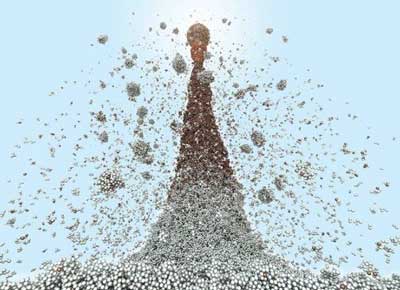| May 21, 2019 | |
Laser focus shines light on how nanoparticles form(Nanowerk News) To make tiny, clean particles that could be used to kill cancer cells, scientists use lasers. The process, called laser ablation, forms small (less than 10 nanometers) and large (10 or more nanometers) particles. To discern between these two sizes, a team modeled interactions between short laser pulses and metal targets (Nanoscale, "Two mechanisms of nanoparticle generation in picosecond laser ablation in liquids: The origin of the bimodal size distribution"). |
|
| The results indicated that smaller particles likely form from the condensation of metal vapor cooled through its interaction with water vapor. Larger particles may emerge when instabilities cause the metal to fall apart. | |
 |
|
| Titan supercomputer tells origin story of nanoparticle size distributions with large-scale simulations. (Image: Oak Ridge National Laboratory) | |
| Finding the source of the size discrepancy paves the way to a future where scientists can optimize laser ablation to control the size of clean nanoparticles. Controlling the size makes them cheaper and more readily available for potential biomedical purposes, such as selectively killing cancer cells. This study could also lead to advances in laser ablation and related methods. In turn, the advances would enable more precise interpretation of existing data. | |
| The team ran molecular dynamics simulations on the Oak Ridge Leadership Computing Facility’s Titan supercomputer to model silver and gold targets in water irradiated by laser ablation, which helped differentiate between the mechanisms responsible for generating small and large nanoparticles. | |
| During ablation, laser pulses superheat part of the metal target’s surface, leading to an explosive decomposition of that region into a mixture containing vapor that condenses to form small nanoparticles. The mixture is ejected from the target, forming the ablation plume, which interacts with the surrounding water and leads to the formation of a hot metal layer. | |
| This dynamic interaction can trigger a rapid succession of hydrodynamic instabilities—unstable flows of one fluid through another fluid of a different density—that cause the molten metal layer to disintegrate and produce large nanoparticles. | |
| The team hopes this work will eventually result in improved laser ablation techniques that control the sizes of nanoparticles, removing the need for the tedious task of sorting them. |
| Source: U.S. Department of Energy, Office of Science | |
|
Subscribe to a free copy of one of our daily Nanowerk Newsletter Email Digests with a compilation of all of the day's news. |
